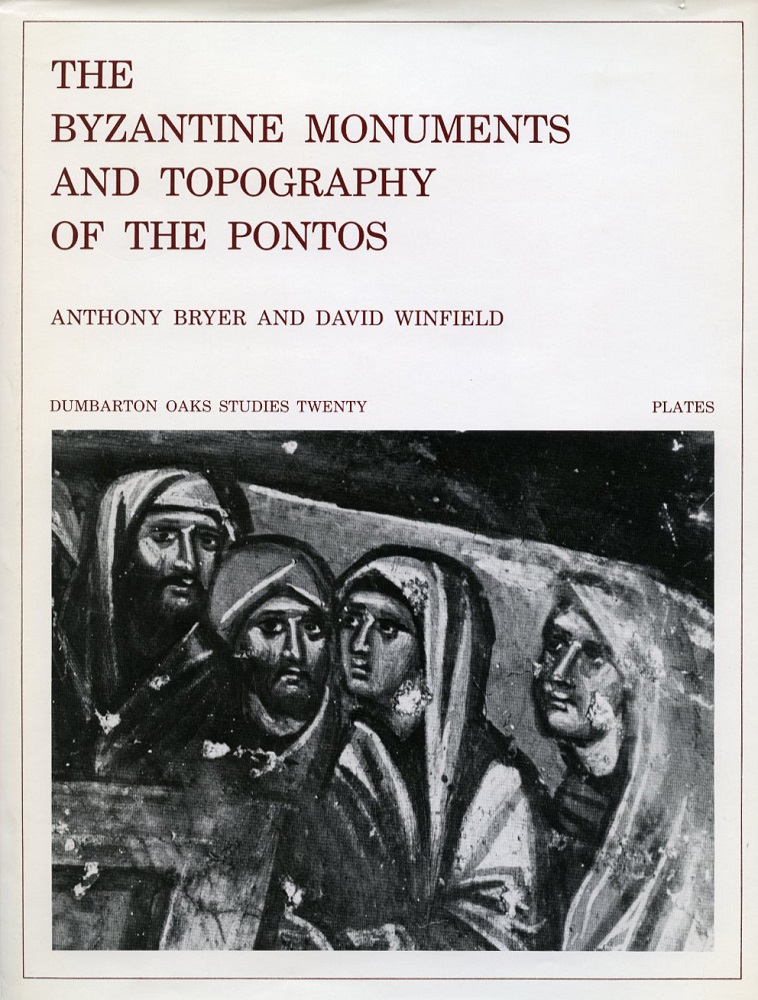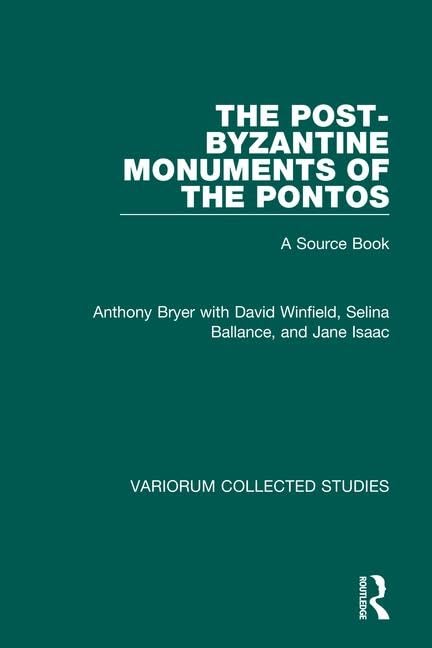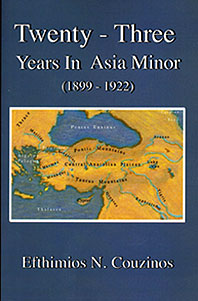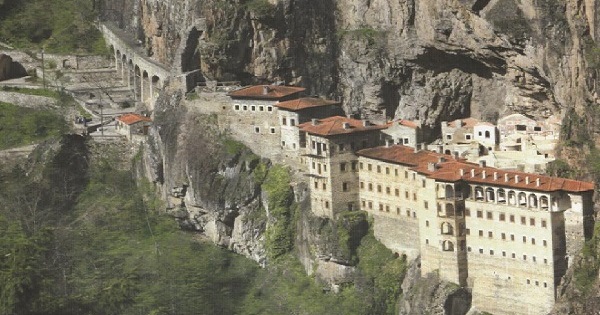
Plate 1: Soumela Monastery. Source
Sam Topalidis, Pontic Historian 2019.
Introduction
The former Greek Orthodox monastery of the Virgin Mary, Soumela (Plate 1) is 48 km south of Trabzon via Machka (Figure 1) in Turkey. The monastery is perched on the cliff face of Karadağ (Mount Mela in English), nearly 300 metres above the west bank of a tributary of the Degirmen Dere (Mill River) in the Altindere National Park.
The monastery complex has five floors and 72 rooms and is apparently built of volcanic andesite, trachyte and travertine limestone. Bricks were also used in its construction (Nuhoglu et al. 2017). Tϋfek (1978) in Köse (2012) states that cut and dressed stonework in Soumela came from the quarries from the Santa high plateaus 17 km away.
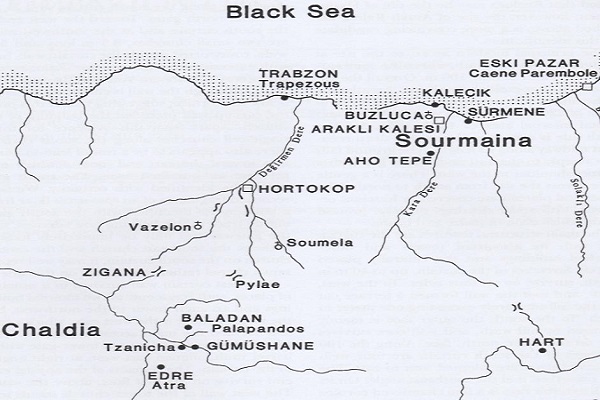
Figure 1: Region south of Trabzon (scale: Trabzon to Gϋmϋshane = 65 km) (Crow and Bryer 1997, p. 285)
The view of the monastery and the view of the surrounding countryside from the monastery are exquisite. ‘The first feeling of the beholder is one of amazement that any human beings should have established themselves in a place apparently so inaccessible’ (Tozer 1881, p. 435).
It is unclear exactly when the monastery was founded. The tradition is that the Soumela Monastery was founded by the Athenian monks Barnabas and Sophronios, who were commanded by the Virgin Mary to take her icon to Pontos. The icon of Panagia (Plate 2), one of the four or five believed to have been painted by St Luke, preceded the monks, coming to the cave on Mount Mela, next to a holy-water fountain. The establishment of Soumela probably occurred by the 10th century. It was abandoned in 1923 (Bryer and Winfield 1985, p. 254).
The Soumela monastery and the icon of Panagia Soumela are extremely important symbols of Pontic Greek identity and are highly revered.
![]()
Plate 2: Panagia Soumela icon (Chrysanthos 1933, p. 991)
The early period - 14th century
Around 1300, the monastery probably consisted of the cave church, the icon of Panagia, the fountain to the southeast of the cave church and wooden cells hanging from the cliff face over the river. It enjoyed the patronage of many Komnenoi emperors of Trebizond. Alexios III Komnenos was responsible for rebuilding the monastery in 1360–65. He also issued an imperial edict, exempting the monastery of all imperial taxes and tributes as well as existing and future dues, from the jurisdiction and authority of the local Matzoukan dukes and from military and financial obligations. Soumela was only obliged to pay into the Imperial Vestiary a twice-yearly tribute. If people settled on its lands (excluding the 40 serfs of the monastery), they would also be excused in the same way and would contribute to the tax district which Soumela enjoyed. Alexios III may also have presented the monastery with an icon of the ‘Rosy-complexioned Mother of God’ (Bryer and Winfield 1985, p. 254). As a result of its isolation, from the 14th century the monastery became prey to thieves (Bryer and Winfield 1970).
1461–1914
In 1461, when the Ottoman sultan Mehmet II conquered Trabzon, the three great Matzoukan monasteries of Peristereota (north of Soumela), Soumela and Vazelon, lost their properties further away in the province of Trabzon but retained their holdings in their neighbourhood in the Matzoukan Valley (Lowry 1991). At this time, the Soumela Monastery probably consisted of the painted cave church (Plate 3), the fountain, possibly a chapel for the relic of the Holy Cross and probably some of the monastic buildings and nine chapels along the rock ledge north of the cave church. Selim, governor of Trabzon (1489–1512) then sultan (1512–20), confirmed the rights of Soumela and presented it with a set of large silver candlesticks (Bryer and Winfield 1985, p. 254).
Another period of prosperity came in the 17th century with endowments as a result of the opening of the silver mines in the Gϋmϋshane area, south of Soumela (Figure 1). The monks of the monastery quarrelled over the new wealth and over such lucrative areas as the vicarate of Koloneia and Shebinkarahisar (to the west), which they controlled until 1693. The Greek archbishops of Chaldia (Figure 1) patronised Soumela, particularly in the period 1686–1744, when almost all the visible wall paintings, most of the chapels and the inner monastic buildings were constructed or decorated. Plates 4 & 5 show some of the paintings on the ceiling in the cave church which were last made in the early 18th century. Older paintings exist underneath these paintings (Bryer and Winfield 1985, pp. 254–55, p. 284).
A further period of prosperity at the monastery began in 1865 with the lifting of restrictions on local crypto-Christians and the establishment of the small diocese of Rhodopolis in 1863 encompassing the three great monasteries of Peristereota, Soumela and Vazelon. These monasteries were great landowners, e.g. in 1890 Peristereota owned 11, Soumela 15 and Vazelon 20 villages, many of which were the result of confirmatory grants between 1364 and 1429 (Bryer and Winfield 1985).
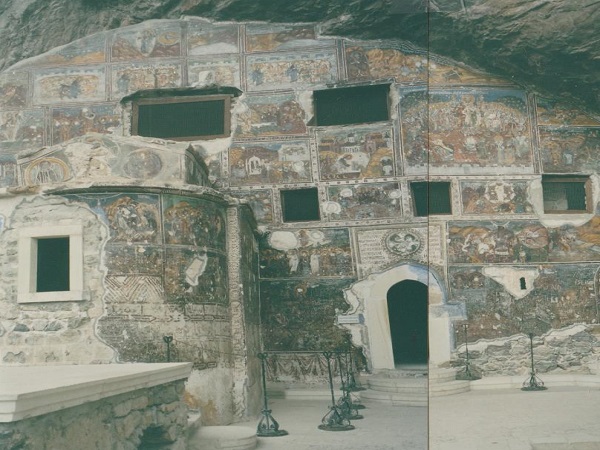
Plate 3: Entrance to the cave church, Soumela monastery (author’s collection 2003)
Just before 1850, the wooden ladder used to enter Soumela was replaced with a stone staircase. In 1864, the monastic approach, the aqueduct (Plate 6), the library (by the entrance) and the façade were built. They also replaced the old wooden cells which had hung from the cliff face. The new building was needed for the thousands of pilgrims (including some Muslims) who came annually on 15 August, to commemorate the death and assumption of the Virgin Mary into Heaven and to venerate the icon of Panagia. These pilgrims largely paid for the rebuilding. The monks from Soumela were experienced fundraisers: between 1744 and 1763 a monk made profitable trips in Anatolia and to Crimea, to collect donations. [In 1701 Soumela had about 40 monks (Tournefort 1741).] Most 19th century abbots of the monastery made fund-raising trips to Pontic Greek communities in Russia. Between 1840 and 1904 the annual income of Soumela rose from [the equivalent in pounds sterling] ₤387 to ₤4,142 (Bryer and Winfield 1985, p. 255).
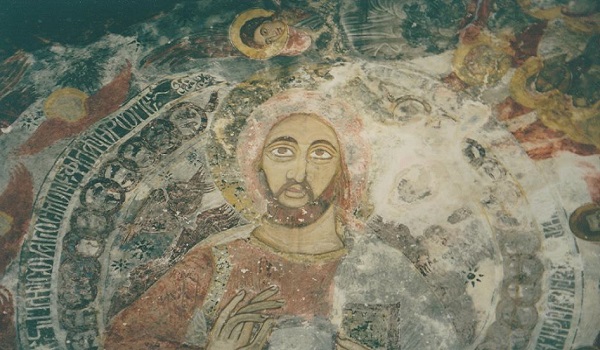
Plate 4: Painting of Christ on the ceiling in the cave church, Soumela Monastery (author’s collection, 2003)
According to Biliotti, the British vice-consul of Trabzon, in December 1877, the monastery, inhabited by 12 monks and some servants was plundered by a gang of 18 Turks. They stole about the equivalent of ₤50 in coins, six silver watches, all the wearing apparel belonging to the monks, five small silver crosses, 17 small silver candlesticks, two chalices, two crosses, two silver trays, several cumbersome church vestments, around 100 kg of copper vessels and some food. Excluding the vestments which the monks’ valued at upwards of ₤1,000, the items stolen amounted to around ₤400. Fortunately, they left the icon of Panagia (Bryer and Winfield 1970, pp. 276–78). In addition to what was stated by Biliotti, the thieves may have also taken the two large silver candlesticks which had been donated by Selim between 1489 and 1520.
Tozer observed that in front of the cave church hung a large wooden semantron (a plank which was struck in lieu of ringing bells) and close by, a newly built five-bell, bell-tower with a dome (Plate 7). (Sadly, both do not seem to have been rebuilt as part of the modern renovations.) Tozer noted that inside the cave church was the famous small icon of Panagia. As a result of the icon’s age and the smoke from the countless candles from devotees, hardly anything more than the old wood on which it is painted was visible (Plate 2); but the icon had a great reputation amongst Muslims as well as Christians. He also noted that due to the bankruptcy of the Ottoman empire, previous privileges to Soumela no longer applied and the monastery had to pay normal taxes (Tozer 1881).
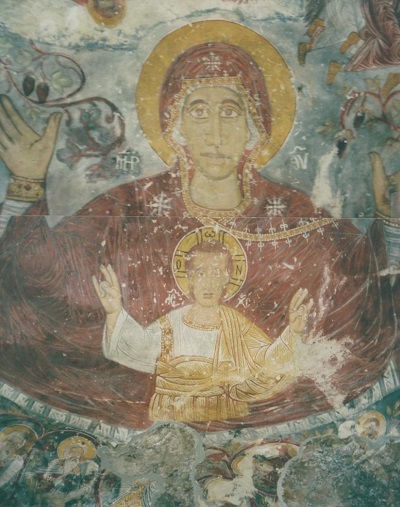
Plate 5: Painting of Mary and Christ on the ceiling of the cave church, Soumela Monastery (author’s collection, 2003)
During World War I
Plate 7 shows the courtyard of the monastery in 1915 and the current renovation of the monastery should replicate this layout of the courtyard. (Note 1.) From 1916 to early 1918, the Russian army occupied the Trabzon region and Soumela did not escape theft during this period. The Russian army officer, Sergei Mintslov, rode five hours on horseback with the Greek Metropolitan of Rhodopolis from Livera to the monastery. The five monks there told Mintslov that during Easter 1916, a detachment of Turkish soldiers forced their entry into the monastery. (The monks were able to escape to Livera.) The Turks stayed at Soumela two months until Russian troops were in the vicinity. When the Turks left they took some silver kitchen utensils, some expensive carpets and one library book. Everything else was left untouched. They did not ruin anything and did not touch the icon of Panagia. Mintslov signed the monastery’s visitors’ book which had been started in the 1660s (Mintslov 1923).
Plate 6: Aqueduct and stone staircase entry to Soumela Monastery (author’s collection 2003)
The preservation of artefacts after the deportation of the Greeks
As part of the 1923 Population Exchange between Greece and Turkey, Greeks including the monks were forced to leave for Greece, thus the monastery ceased to function. In August 1923, just before their deportation, the last abbot of Soumela, Jeremias, and his monks hid the icon of Panagia, the handwritten Gospel by St Christopher and the Holy Cross donated by Manuel III Komnenos (1390–1417) in an iron chest. They buried the treasures in the floor of the basement of the small St Barbara church (around one km from Soumela, Plate 8) (Holy Apostles Convent, 1991). 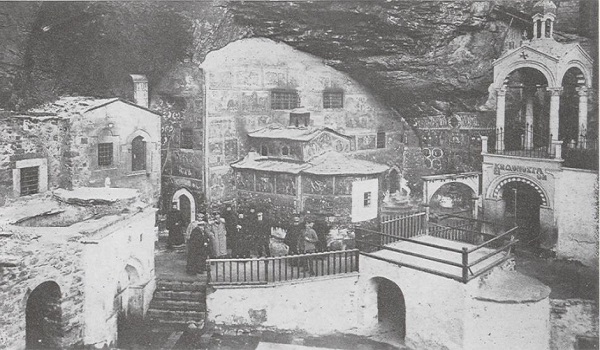
Plate 7: Courtyard of Soumela Monastery, 1915 (Chrysanthos 1933, p. 984)
In 1931, Greece was given permission for the recovery of the icon of Panagia and other treasures from Soumela. In Athens, the ‘former’ Greek Metropolitan of Trabzon, Chrysanthos, selected Ambrosios, a former monk from Soumela, for the task. [Chrysanthos was unable to return as he was condemned to death if he returned to Turkey.] In October 1931, Ambrosios returned to the St Barbara church, recovered the treasures and returned them to Athens. Chrysanthos then deposited these items for safekeeping with the Benaki Museum in Athens until a new church could be built to house the icon of Panagia. In 1950, Pontic Greeks decided to build a new church to Panagia Soumela in the village of Kastania between Kozani and Veria in northern Greece. The icon of Panagia was finally placed in the new church of Panagia Soumela at Kastania on 15 August 1952 (Holy Apostles Convent, 1991). This church is still heavily patronised by the faithful on 15 August to pay homage to the icon of Panagia Soumela.
As far as other items are concerned, the reliquary of the Holy Cross, given by Manuel III Komnenos (1390–1417) is now in the Byzantine Museum, Athens; the icon of the ‘Rosy-complexioned Mother of God’ is in the National Gallery, Dublin; another icon from the monastery is in a private collection in Oxford; and the probable icon screen is in private hands in America. Sixty-seven of the former 84 MSS [manuscripts] and about 150 printed books from the monastery’s library are in the Archaeological Museum of Ankara (Bryer and Winfield 1985, p. 255). In 1992, during renovations at Soumela, two icons were found and were placed on display in the Trabzon Museum (Köse 2010). In 1993, the Cross and the Gospel of St Christopher were delivered to the Byzantine Museum, Athens (Papantoniou 2013).
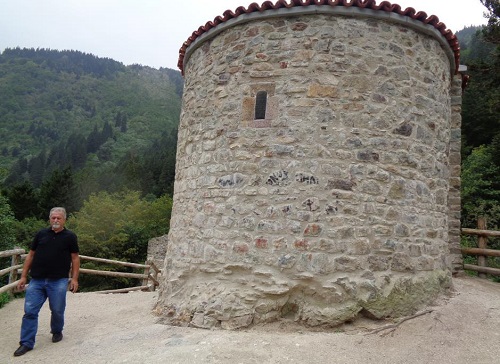
Plate 8: Renovated St Barbara church near Soumela Monastery (author’s collection, 2018)
Closure and the path to restoration
After the Soumela monastery was abandoned in 1923, it was used by tobacco smugglers and was then gutted by a fire around 1930. After it was abandoned, it suffered badly from vandals. (Plates 9 & 10, taken by Professor Talbot Rice in 1929, before fire gutted the monastery, show the result of some of the vandalism.) In 1961 it became the headquarters of a State Experimental Forest and that Soumela survives today was due to the efforts of Şϋkrϋ Köse, its first Chief Ranger (Bryer and Winfield 1985). In the 1960s, Şϋkrϋ Köse held the key to the gate to Soumela and thus controlled access by tourists.
Tϋfek (1978) in Bryer and Winfield (1985) reported the discovery of a secret chapel, one of four, in the cliff face about 100 m north of the monastery proper, which apparently had been ‘lost’ since 1893. Köse (2012) states that the hidden chapel was also used as an observation post and had been damaged by treasure hunters.
In 1972, the monastery, still in ruins, was taken over by the Trabzon Museum (Holy Apostles Convent, 1991). The restoration of the monastery began in the 1980s (Köse 2010).
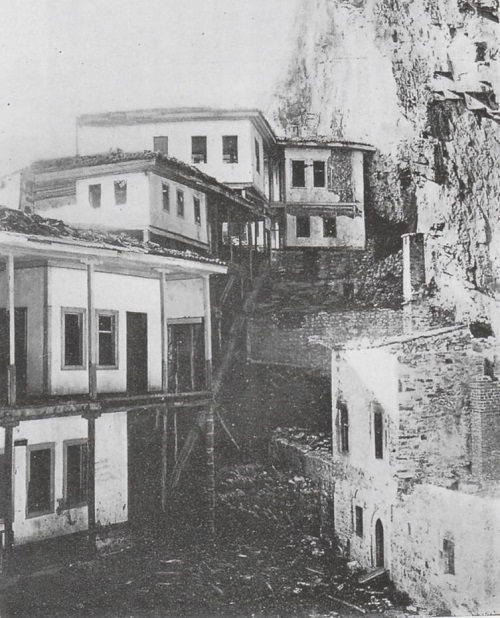
Plate 9: Soumela Monastery looking towards the exit stairs (1929 photograph by Talbot Rice in Chrysanthos (1933, p. 986))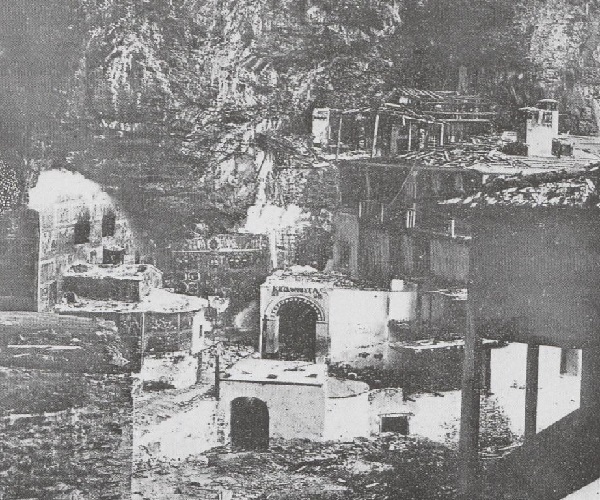
Plate 10: Courtyard in the Soumela Monastery (1929 photograph by Talbot Rice in Bryer and Winfield (1985, Plate 209))
Soumela today
The so called, ‘renovated’ Soumela Monastery (Plate 11, compare to Plate 7) was open in 2010 for an annual 15 August Greek Orthodox church service conducted by the Ecumenical Patriarch of Constantinople, Bartholomew. (The last church service on 15 August had been conducted in Soumela in 1922.) These annual services lasted until 2015 as the monastery has been closed since September 2015 to repair some of the renovation work to the building and to secure the rocks above the monastery. The monastery will hopefully be open to tourists in 2019 and for the 15 August 2019 Greek Orthodox service by the Ecumenical Patriarch.
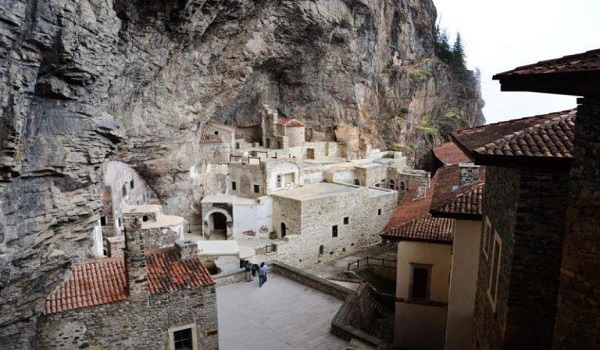
Plate 11: ‘Renovated’ Soumela Monastery (Neos Kosmos, Greek Newspaper, Melbourne, 11 December 2017)
While the site was open, it was one of the most popular tourist destinations in the Trabzon region. The narrow gateway at the top of the stairs into the monastery (Plate 6), which allows only one person to pass at a time, combined with the limited space in the internal area of the monastery, restricts the number of tourists who can visit daily. Despite this, apparently, in 2012, 230,000 tourists visited the Soumela Monastery. No doubt there has been a considerable loss of valuable tourist revenue from the Trabzon area since the monastery has been closed. See you at Soumela.
Note 1
Also, in 1915, during the Ottoman massacre of Christian Armenians (genocide), monks from the Soumela Monastery hid around 40 wounded Armenian men in a nearby cave (Surmelian 1946).
Acknowledgements
I thank the talented Michael Bennett and Russell McCaskie for their suggestions to clarify this work.
References
Bryer, A and Winfield, D 1970, ‘Nineteenth-century monuments in the city and vilayet of Trebizond: architectural and historical notes’—part 3, Archeion Pontou (Archives of Pontos) vol. 30, pp 228–375.
Bryer, A and Winfield, D 1985, The Byzantine monuments and topography of the Pontos, vols I & II, Dumbarton Oaks Research Library and Collection, Harvard University, Washington DC.
Chrysanthos 1933, ‘H Eκκλησια Τραπεζουντος’, (in Katharevousa Greek), [The church of Trabzon], Archeion Pontou [Archives of Pontos], vol. iv-v, Athens.
Crow, J and Bryer, A 1997, ‘Survey in Trabzon and Gϋmϋşhane vilayets, Turkey, 1992–1994’, Dumbarton Oaks Papers, vol. 51, pp. 283–89.
Holy Apostles Convent, 1991, The lives of the monastery builders of Soumela, (a translation from the Greek of The Great Synaxaristes of the Orthodox church), Pamphlet no. 2, Holy Apostles Convent, Buena Vista, Colorado, USA.
Köse, I 2010, The monastery hidden above the clouds: Soumela, Akademi Kitabevi, Trabzon.
Köse, I 2012, ‘The monastery of Soumela and ancient trade routes connected to it’, Codrul Cosminului, XVIII (I), pp. 7–28.
Lowry, H 1991, ‘The fate of Byzantine monastic properties under the Ottomans: examples from Mount Athos, Limnos & Trabzon’, Manzikert to Lepanto: the Byzantine world and the Turks, 1071–1571. Papers given at the nineteenth Spring Symposium of Byzantine Studies, March 1985, (eds A Bryer & M Ursinus), Adolf M Hakkert, Amsterdam, pp. 275–311.
Mintslov, SR 1923, Trapezondskaia epopeia, (in Russian) [Russian accounts of Trabzon], Sibirskoe Knigoizdatel’stvo, Berlin, (unpublished translation from Russian into English by Russell McCaskie).
Nuhoglu, Y Var, M Koçak, E Uslu, H & Demir, H 2017, ‘In situ investigation of the biodeteriorative microorganisms lived on stone surfaces of the Sumela Monastery (Trabzon, Turkey)’, Journal of Environmental & Analytical Toxicology, vol. 7 (5), 10 pp.
Papantoniou, M 2013, ‘The history of Panagia Soumela Holy Icon’, Greek Reporter, 10 August 2013, at https://greece.greekreporter.com/2013/08/10/the-history-of-panagia-soumela-holy-icon/
Surmelian, LZ 1946, I ask you, ladies and gentlemen, Victor Gollancz Ltd, London.
Tournefort, JP de 1741, A voyage into the Levant, vol. III, letter v, (translated from French to English by John Ozell), London.
Tozer, HF 1881, Turkish Armenia and eastern Asia Minor, Longmans Green and Co, London.
Tϋfek, Ö 1978, Sumela, Meryemana, (in Turkish and English), Istanbul.
